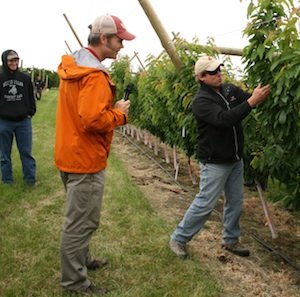
Grower Mark Hanrahan (right) tells Dr. Matt Whiting of his concerns about shading in this UFO cherry block.
Cherry growers from Washington and Oregon braved unseasonably cold and wet weather to learn about the latest developments in cherry research and production.
At Washington State University’s Irrigated Agriculture Research and Extension Center in Prosser, cherry horticulturist Dr. Matt Whiting discussed the latest developments with the UFO (Upright Fruiting Offshoots) training system. Trees are planted at a 45-degree angle, and the trunk is trained horizontally along a trellis wire, with the branches on the top side of the trunk trained vertically. Whiting said he has learned through his experiments that it’s best to keep the trees growing at a 45-degree angle for the first season until there’s good shoot growth off the upper part of the trunk, rather than bending them horizontal at the time of planting. This avoids dominant upright shoots developing off the lower part of the trunk. He is running a trial to look at the best timing for bending the leader.
The pruning concept for the UFO is that when an upright shoot becomes too large, it is removed. He’s also been studying the best time to remove the uprights, and whether leaving a stub is better than cutting the upright off flush with the leader. Results show that it is better to leave a stub, cutting an inch or two above the lowest live bud, than to cut the entire shoot off, and regrowth is best when the shoot is removed during the dormant or full-bloom periods rather than postharvest.
Trials are underway with mechanical pruning in UFO blocks. Next year, Whiting will experiment with machine harvesting (a shake-and-catch system) in the UFO system.
Cherry rootstocks
Dr. Amy Iezzoni, cherry rootstock breeder at Michigan State University, discussed a trial she is heading at Prosser to evaluate 11 candidate rootstocks from MSU. The trial was planted in 2009 with Bing as the scion. The rootstocks are named after Michigan counties. Tom Auvil, research horticulturist with the Washington Tree Fruit Research Commission, said trees on Clare had noticeably more bloom this year than trees on other rootstocks, but Clinton was the most precocious. Trees on Crawford and Clinton have a spreading growth habit, whereas those on Cass, Clare, and Lake are more upright.
Iezzoni said the most promising rootstocks are being treated at the National Clean Plant Network, and three have been released to seven commercial nurseries for testing and propagation.
Lynn Long, Oregon State University Extension agent in The Dalles, said growers are looking for attributes that the Gisela rootstocks don’t have. They’re particularly interested in rootstocks of intermediate precocity so they can grow a productive variety like Sweetheart without producing so much fruit that the cherries are too small. For Regina, a comparatively unproductive variety, they’re looking for a rootstock with better productivity.
The tour, held on June 4, also highlighted research on a stationary solid-set pesticide application system, mechanical harvesting aids, and a real-time harvest monitoring system that can track the weight of cherries picked by individual workers and transmit the data to a computer for payroll or decision-making purposes.
Mulches
The Oregon tour on June 5 visited several commercial orchards. John Carter discussed various mulches he has used, including a black plastic fabric, straw, and wood chips. He’s found the black plastic fabric to be very effective, reducing his water use by 30 to 40 percent, and it also seemed to enhance tree growth. “Soil tilth is amazingly improved over what it was
Carter applies Dirt Hugger compost that is produced locally, and also uses it to make compost tea, which he brews for 20 to 24 hours to increase the microbial population. He applies it immediately with weed sprayers, which are reserved for that purpose and not used for herbicides.
“It’s not scientific,” he said, “But the net result is you can see some benefit in improving the porosity and tilth of the soil. It takes effort to be able to do this, and I would not be doing it if I didn’t see results.
“If you have virgin soil, you probably don’t have to do these weird things,” he added. “But many of us have some burned-out soil and marginal soil, and you’ll end up with marginal fruit if you don’t do a little bit extra to make sure your fruit is competitive with your neighbor’s with a little better location. There’s a huge amount of price difference between a 9- and 10-row cherry. If there’s something we can do to make a bigger cherry, that’s where we should be.”
Carter applies the tea only to the ground and no longer makes foliar applications. Some people say it has a fungicidal effect, but Carter didn’t notice any visible difference. “If I can’t see it from my pickup at 25 miles per hour, it’s not good enough,” he commented.
Rodents
Carter said mice are a tremendous problem, particularly in blocks with the black fabric mulch. He applies bait three times a year, twice with a gopher machine and once by hand.
Orchardist Mike Omeg noted that many growers in The Dalles area have owl boxes to encourage owls to nest there and feed on rodents. If the birds use the boxes, they can have an impact, as one family of owls eats 3,000 gophers per year, but it can take years for them to take up residence.
He encouraged growers who use baits to select those that are the least toxic to birds of prey. Rozol (chlorophacinone) is more toxic to mice, rats, and squirrels than Ramik Green (diphacinone), but is much less toxic to nontarget animals, he said.

Leave A Comment